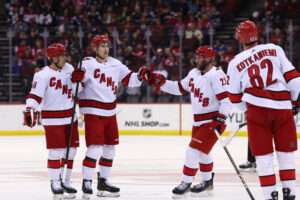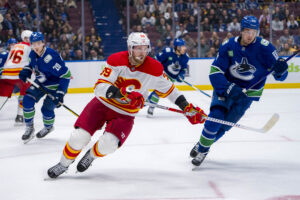And so it ends… until the Seattle Kraken join the league and the Vancouver Canucks draft has a 32nd selection.
The Best Vancouver Canucks Draft Picks
By the time the end of the first round comes about, the picks are getting thin on the ground. The obvious talent has already been selected, and for a lot of years scouting was “I heard this guy’s good.” It’s more difficult to miss the picks nowadays, but that doesn’t mean it doesn’t happen. Missing here is easier, but still carries that cachet of being “a first-rounder” which is rather unfair. So, with a quick word to the memories of late selections past, let’s dig in.
26th overall
Choices: Bob Manno, Brent Ashton, Cory Schneider, Brendan Gaunce
The Canadian-born Manno never got a full season in five years with the Canucks. He got more ice time after he left, playing in the 1982 All-Star game for the Toronto Maple Leafs. After two more years with the Detroit Red Wings, he decided to finish his career being a star in Italy. Gaunce was selected as a bit of a project, but he never panned out. He still got in 118 NHL games, but wasn’t sound enough defensively to compensate for weak scoring. Swing and a miss, with current Canucks Tanner Pearson being selected four picks later.
Ashton’s career never took him to Italy, but he racked up a LOT more air miles then Manno. We’re pretty sure league general managers were playing a strange practical joke on him. He played for eight (EIGHT!) NHL teams in just 13 years – and never signed with a new team as a free agent. Ashton was traded eight times – four times mid-season. His first time with the Winnipeg Jets he didn’t play with them – he did the second time, though!
Cory Schneider was caught up in the Ongoing Goalie Saga that was the Canucks’ Roberto Luongo years, which is a shame. He played excellently for the team, but between sitting behind an expensive All-Time goalie and inner team drama (Ryan Kesler, again), he was eventually moved for the ninth overall pick in the 2013 draft. That’s one of the picks Vancouver got very right. How good was Schneider? Good enough for a .927 save percentage in 98 career games with the Canucks. Whether or not he was worth a top-10 pick, that was what he cost.
Verdict: Schneider. The second-highest pick the Canucks have ever used on a goaltender, one spot behind Troy Gamble.
27th Overall
Choices: None
Just kinda weird to see. 51 drafts have gone by, and the Canucks have yet to select 27th overall.
Verdict: Weird.
28th Overall
Choices: Brad Gasshoff
Gasshoff… well, you can see why he was a Vancouver Canucks’ draft pick. He scored 50 goals and 59 assists in 69 games with the Kamloops Chiefs of the WHL, with 251 penalty minutes. He had a lot fewer points the previous year (16 goals, 41 points) but not many fewer penalty minutes (245). This changed dramatically when he reached the Canucks, with 19 goals and 36 points in 122 games and just 163 penalty minutes. His Central Hockey League career saw him with 899 minutes in just 221 career games. Can’t say we blame him for retiring!
Verdict: Gasshoff. And we mean this in the best possible way.
29th Overall
Choices: Rob Woodward, Jassen Cullimore, Nicklas Jensen
Three interesting choices, here. The first, Woodward, was all over the place in pre-draft listings. His own mother said “he doesn’t know how to play the game yet.” Ouch! She blamed the high school system in Chicago at the time, which… okay, fair enough. It was 1989, after all. After getting projected anywhere from 14th to 60th, the Canucks drafted him early in what was then the second round. In return, he went to Michigan State for four years, played in the AHL for one, then decided hockey wasn’t for him and retired. Four years later, he joined the ECHL’s Columbus Chill for their final season in 1998-99. That’s one heck of a trip!
Question for all hockey fans: if you’re a perpetual “tweener” – bouncing between the minors and the NHL – do you tough it out and hope? Or take your skills to Europe, get paid, and live a pretty good life in a new country (or several)? Cullimore was a 6′-5″ defender who couldn’t quite break through until the Tampa Bay Lightning got him off waivers seven years after he was drafted. And in 2003-04, he was rewarded with the Stanley Cup. He built a 15-year NHL career, got his Cup, and still spent a year in Germany before retiring. So why not both?
By the time Jensen was chosen, Jannik Hansen had established himself as a full-time NHLer. Ends up not all Danes have the same mentality. Jensen utterly dominated his own age group, playing professionally – and productively – in the Danish men’s league at 17. But he never found that extra gear in the NHL, and has been back in Europe for the last four years.
Verdict: Cullimore.
30th Overall
Choices: Ed Dyck, David Bruce
Pour one out for the expansion team goalies. Dyck was drafted long enough ago that he was taken in the third round of Vancouver’s inaugural season. And, well, it shows. In 49 games with the Canucks, Dyck had eight wins and an .859 save percentage. He lasted three years in the NHL and one in the WHA before retiring. Bruce did better, if only by virtue of not just playing for totally awful teams. The left wing played 254 NHL games in eight years, and even had a 22-goal season with the expansion San Jose Sharks in their first year.
Verdict: Bruce. Bit tough comparing a forward to a goalie, though.
31st Overall
Choices: Jeff Rohlicek, Artem Chubarov
Some of the most frustrating players are ones who produce like Rohlicek. A 97-point WHL regular season followed by 13 goals and 21 points in the playoffs gets you drafted. He continued to produce fantastic numbers in junior, doing great in the minors as well. Heck, he had 47 goals and 110 points with the Milwaukee Admirals, for crying out loud! But his NHL totals? Just nine games and zero points.
There were hopes that Chubarov would break an informal streak for the Canucks: getting a Russian to stick. Not all draft picks are going to hit, and there are only so many taken each year. But it had seemed that Russians and the Vancouver Canucks draft might not be working out. That year saw an incredibly messy break with superstar Pavel Bure bringing up memories of two other Russian stars that didn’t work out for the team. The team gave up on Evgeny Namestnikov the year before, the oft-injured Alexander Mogilny‘s star had faded after one year. Would Chubarov turn it around? Nope! He ended up being a precursor to their Russian luck. It would be 10 picks and 14 years years later before another would play more than 10 NHL games.
Verdict: Chubarov. Hey, 25 goals and 58 points in 228 NHL games isn’t bad…
The Vancouver Canucks Draft Conclusions
It’s fun to flash back in time to see who and what might have been different. It’s also fun to try guessing what was going through the heads of scouts and GMs at the time. Like picking Nicklas Jensen was obvious: great success with Jannik Hansen, and he was pulling great numbers against adults! Looking back now, you can see the drive Hansen had that Jensen simply didn’t. The Vancouver Canucks’ draft pick – their latest ever at 287th overall – forced his way onto the team, knowing he was an underdog. Would Jensen get drafted now? Sure, but closer to Hansen’s position than in the first round.
It’s interesting to compare just how well they did at each spot, too. The deeper drafts found gold in round 23, for instance. You can understand why some big swings are taken later in the round when you see the hit-and-miss record that normally happens.
As for a conclusion? Scouting got better over time, and in more places. Seeing when players from around the world were selected is shorthand for the Canucks’ – and the NHL’s – increasingly international perspective.
Here are parts One, Two, Three, and Four.
Main Photo:






